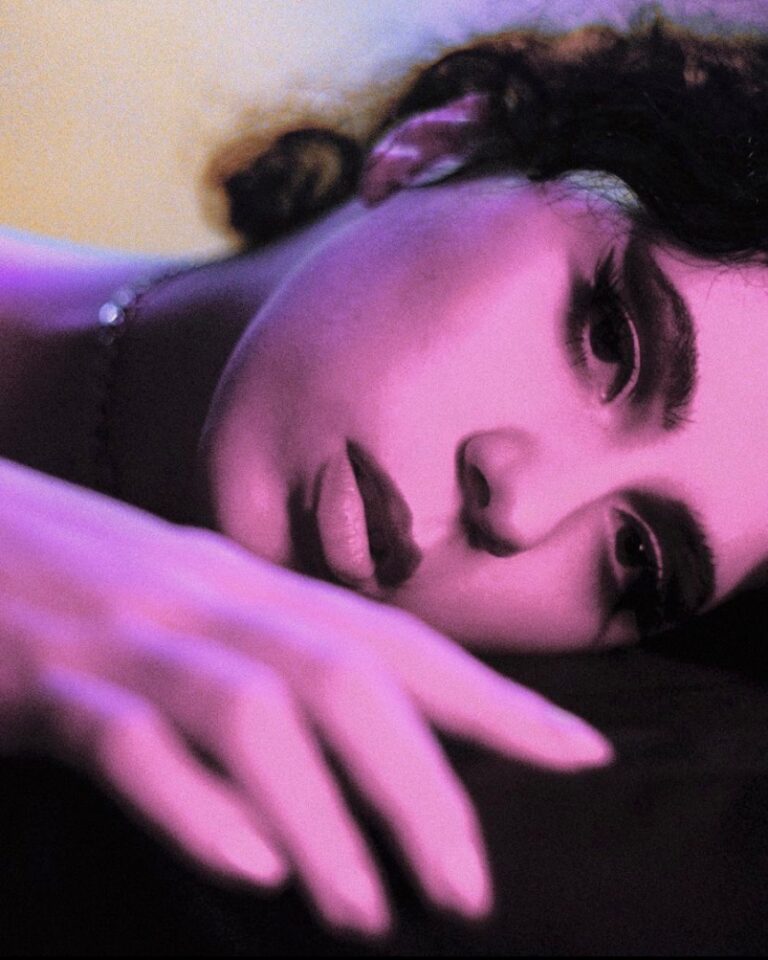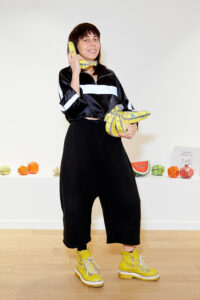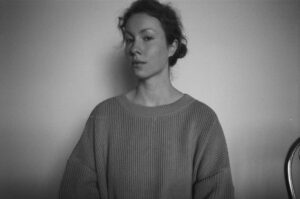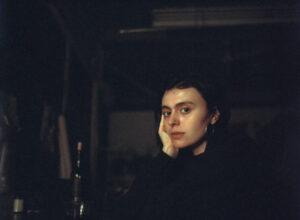Anastasija Pavić

– (1998) is a multimedia artist residing and creating in Belgrade. She holds a degree in New Media Art from the Faculty of Fine Arts at the University of Belgrade. In her artistic practice, Pavić navigates contemporary themes, exploring post-cyber feminism, consumerism, interpersonal dynamics, and the impacts of technological evolution on self-perception and identity. She has actively contributed to numerous exhibitions in Serbia and abroad, showcasing her work in four solo shows and participating in online exhibitions supported by The Wrong Biennale and Ars Electronica. She finds her expression through performance, video, photography, writing and art direction. Between 2021 and 2024, Pavić was represented by gallery Novembar in Belgrade, and now works as an independent artist. In the year 2023 she was selected as a finalist for the Dimitrije Bašičević Mangelos Young Visual Artist Award which is organised in collaboration with the Residency Unlimited in New York. Her artistic contributions have found recognition in prominent publications, including Elle and Fraulein magazine, as well as Serbian art magazines such as Manek and Selfi.
The importance of art is reflected in the personal, but also in the collective experience. Actually, I think the two are intertwined. At the age of ten, I had the privilege to visit the Centre Pompidou in Paris. It was the first time I attended a contemporary art exhibition and after I left the museum, I burst into tears. When I was asked why I was crying, I said that I dreamed about the sounds that were a part of one of the exhibited installations. I was very upset, primarily because I was confused as to how it was possible for the author of that work and me to have something in common, which is at the same time so intimate and so abstract?
Over the years, I realised how interested I am in visual culture. What fascinated me the most was the power of symbols in the context of conveying a message. It’s almost magical how much you can say without having to say anything. I’m very inspired by pop culture, trends and clichés. The video performance “I CAN MOVE MOUNTAINS”1 is an ode to the well-known expression “I would move mountains for you”, one we have heard countless times in movies, series and songs. According to art historian Maja Petrović, the work speaks of the absurdity of ambitions and feats, whose expressions – unfounded in reality, become empty phrases and performative actions that expose their banality.
Unfortunately, the situation is such that only a few can make a living from their art. That’s why I believe that anyone who is honest with themselves and in their work, makes art because they feel like they have to. I make art because I feel responsible. Even if it’s purely aesthetic, doing art in this region, while capitalism is in full swing is a statement in itself. During the process of creating the work “Onlyfans” in 2020, I realised that a correlation can be made between the increased number of content consumers due to the pandemic and the increasing number of authors of that content generated by the economic crisis. OnlyFans and similar platforms are a reflection of an endless cycle in which an individual surrenders to a system that is dysfunctional in order to survive within it. The problem is not the individual themself, forced to choose whether to exploit their body in “this” or “that” way, because they will surely use it for profit, even if they do not take off a single piece of their clothing. The problem lies in the social glorification of that action, because the monetary gain from errors in the system creates the illusion of power, while it is actually a licence to feed off of the system’s participants.
I have always attached great importance to education and respected institutions, so I took my academic achievement at the Faculty of Fine Arts in Belgrade seriously. To my great disappointment, I ended up in an institution that is not only conservative, but full of sexual predators and people prone to verbal violence. Many times, I was put in situations by different individuals where I felt helpless and even blackmailed. It is sad that I am not the only one with this kind of experience and that this behaviour is not sanctioned, because reports are directed through the “my word against his” filter, and we all know that institutions show more understanding for the middle-aged men, who are respected in their profession, than 18 year old girls. Even sadder is that these things are common knowledge, but people consciously choose to turn their heads the other way.
I think it would be better for me not to view my profession as a part of my identity, but it’s very difficult to do so when inspiration comes from trauma. In my case, the side effect of creation is also a kind of therapy. In my work, I reflect on the position of a woman in modern society and the construct of partnership relations. Artwork ideas come to me from the constant questioning of myself, my performativity and complexes. I am inspired by everyday life and its injustices, especially from the perspective of women and LGBTQ members in the Balkans, but also on a global level. Globalisation is essential as far as my generation is concerned. We grew up on social media and it has shaped our perception a lot. That is one of the reasons why it would be difficult for me to declare myself as an artist with an exclusively Serbian national identity.
In the work “Babygirl”,2 I dealt with power relations using fictitious figures of a dominant and an inferior persons. The characteristics of the inferior person, i.e. Babygirl, are ideal female traits that are imposed by society and imply passivity. These are clichés, which should be avoided, but at the same time, they are the biggest comfort zone. Such a state implies another person who is active in this case and who provides the inferior one with everything she needs to function in general. This means that the dominant person is in control, but also bears responsibility. I saw that pattern as a kind of human need to play a certain role, which determines the dynamics of the relationship from the beginning. I had a lot of fun translating that into photos – with the help of Goran Popovski – which present me in a manner between fantasy and parody, in a carrier (which is a hybrid design of a carrier for children and a sex swing), sexualized and infantile at the same time.
I am very interested in body modifications that occur due to social pressure and propaganda, because feminism is an important part of my practice. I am intrigued by how aesthetic alterations are connected with our psyche and emotions. I addressed this in the work New Body. In the last few years, there has been an expansion in availability and demand in this field, among other reasons, because the icon of our time – Kim Kardashian, over time and under the watchful eye of the public, “made” herself into an ideal. During the performance “Can I Rest in Peace?”3 I wore a copy of the Marilyn Monroe dress that Kim wore to the Met Gala 2022, except that it was made of biodegradable material. The aim is to confront that daily marketed perfection with the inevitable mortality and disintegration. I try not to judge in my works, but as my dear colleague, curator Ana Simona Zelenović says, there is a simultaneous critical and affirmative approach.
The text was written in collaboration with Mirjana Dragosavljević (2022).
1Illustration: Anastasija Pavić, I Can Move Mountains, video performance, 2020, courtesy of the artist.2Illustration: Anastasija Pavić, Babygirl, photographs, 2022, photo: Goran Popovski, courtesy of the artist.
3Illustration: Anastasija Pavić, Can I Rest in Peace, performance, 2022, courtesy of the artist.
– (1998) je multimedijalna umetnica koja živi i stvara u Beogradu. Ima diplomu iz Nove medijske umetnosti na Fakultetu likovnih umetnosti Univerziteta u Beogradu. U svojoj umetničkoj praksi, Pavić istražuje savremene teme, baveći se post-cyber feminizmom, potrošaštvom, međuljudskim dinamikama i uticajem tehnološke evolucije na samopouzdanje i identitet. Aktivno je učestvovala na brojnim izložbama u Srbiji i inostranstvu, prikazujući svoj rad na četiri samostalne izložbe i učestvujući u online izložbama koje podržavaju The Wrong Biennale i Ars Electronica. Svoje izražavanje pronalazi kroz performans, video, fotografiju, pisanje i umetničku direkciju. Između 2021. i 2024. godine, Pavić je bila predstavljena u galeriji Novembar u Beogradu, a sada radi kao nezavisna umetnica. U 2023. godini izabrana je kao finalistkinja za nagradu Dimitrije Bašičević Mangelos za mlade vizuelne umetnike, koja se organizuje u saradnji sa Residency Unlimited u Njujorku. Njen umetnički doprinos je prepoznat u istaknutim publikacijama, uključujući časopise Elle i Fraulein, kao i srpske umetničke časopise kao što su Manek i Selfi.
Važnost umetnosti se ogleda u ličnom, ali i u kolektivnom doživljaju. Zapravo, smatram da se ta dva prepliću. Sa deset godina sam imala privilegiju da posetim Centar Žorž Pompidu u Parizu. To je bio prvi put da sam prisustvovala izložbi savremene umetnosti i nakon što sam napustila muzej, rasplakala sam se. Kada su me pitali zašto plačem, rekla sam da sam sanjala zvukove koji su bili deo jedne od izloženih instalacija. Bila sam jako uznemirena, pre svega jer sam bila zbunjena kako je moguće da autor/ka tog rada i ja imamo nešto zajedničko, što je ujedno tako intimno i apstraktno?
Tokom godina sam shvatila koliko me interesuje vizuelna kultura. Najviše me je fasciniralo kakvu moć imaju simboli u kontekstu prenošenja poruke. Skoro da je magično koliko toga možeš da kažeš, a da ne moraš ništa da kažeš. Veoma me inspirišu pop kultura, trendovi i klišei. “I CAN MOVE MONTAINS”1 video performans je oda poznatom izrazu “I would move mountains for you” koji smo nebrojano puta čuli u filmovima,serijama i pesmama. Prema rečima istoričarke umetnosti Maje Petrović, rad govori o apsurdu ambicija i podviga, čiji izrazi neutemeljeni u realnosti, postaju isprazne fraze, performativne radnje kojima se ogoljava njihova banalnost.
Nažalost je situacija takva da samo retki mogu da žive od svoje umetnosti. Zbog toga smatram, da svako ko je iskren prema sebi i u svom radu, pravi umetnost zato što se oseća kao da mora. Ja pravim umetnost jer se osećam odgovornom. Čak i ako je isključivo u estetskom smislu, baviti se umetnošću na ovim prostorima dok je kapitalizam u punom jeku je izjava, samo po sebi. Tokom procesa stvaranja rada “Onlyfans” 2020, sam shvatila da se može napraviti korelacija izmedju povećanog broja potrošača sadržaja zbog pandemije i sve veće količine autora tog sadržaja izazvanih ekonomskom krizom. Onlyfans i slične platforme predstavljaju odraz beskrajnog ciklusa u kojem se pojedinac prepušta sistemu koji je nefunkcionalan da bi mogao da preživi u njemu. Problem nije sam pojedinac koji je prinuđen da bira da li će svoje telo eksploatisati na „ovaj“ ili „onaj“ način, jer će ga sigurno iskoristiti za profit, čak i ako ne skine ni jedan komad odeće. Problem leži u društvenom veličanju te akcije, jer novčana dobit od grešaka u sistemu stvara iluziju moći, a zapravo je dozvola da se hrani učesnicima sistema.
Oduvek sam veliku važnost pripisivala obrazovanju i poštovala institucije, pa sam ozbiljno shvatala i svoj akademski uspeh na Fakultetu likovnih umetnosti u Beogradu. Na moje veliko razočarenje završila sam u instituciji koja ne samo da je konzervativna, već je puna seksualnih predatora i osoba sklonih verbalnom nasilju. Mnogo puta, od različitih pojedinaca sam stavljena u situacije u kojima sam se osećala bespomoćno, pa čak i ucenjeno. Tužno je što nisam jedina sa ovakvim iskustvom i što se to ne sankcioniše, jer se prijave vode na osnovu “moja reč protiv njegove”, a svi znamo da ustanove imaju više razumevanja za sredovečne muškarce, koji su poštovani u svojoj profesiji, nego devojke od 18 godina. Još tužnije je da su te stvari javno opšte poznate, ali ljudi svesno biraju da okrenu glavu na drugu stranu.
Mislim da bi bilo bolje za mene da ne gledam svoju profesiju kao deo svog identita, ali je to jako teško uraditi u slučaju kad inspiracija dolazi iz traume. Nuspojava stvaranja je u mom slučaju i vrsta terapije. U svom radu se bavim promatranjem pozicije žene u savremenom društvu i konstruktom partnerskih odnosa. Ideje za radove mi dolaze iz konstantnog preispitivanja sebe, svoje performativnosti i kompleksa. Inspiriše me svakodnevni život i njegove nepravde, posebno iz perspektive žena i LGBTQ pripadnika na Balkanu, ali i na globalnom nivou. Globalizacija je neizostavna što se moje generacije tiče, odrasli smo na društvenim mrežama i to je jako oblikovalo našu percepciju. To je jedan od razloga zašto bi mi bilo teško da se izjasnim kao umetnica sa isključivo srpskim nacionalnim identitetom.
U radu “Babygirl”2 sam se bavila odnosima moći koristeći fiktivne figure dominatne i inferiorne osobe. Osobine inferiorne osobe tj. Babygirl, su idealne ženske osobine koje se nameću od strane društva i podrazumevaju pasivnost. To su klišei, koje treba izbegavati, ali su u isto vreme i najveća zona komfora. Takvo stanje podrazumeva drugu osobu koja je u ovom slučaju aktivna i obezbedjuje inferiornoj sve što joj je potrebno za generalno funkcionisanje. To znači da dominatna osoba ima kontrolu, ali i snosi odgovornost. Taj patern sam uvidela kao neku vrstu ljudske potrebe da se nosi odredjena uloga, koja u startu odredjuje dinamiku odnosa. Bilo mi je jako zabavno da to prenesem u fotografije, uz pomoć Gorana Popovskog, koje me prikazuju izmedju fantazije i parodije, u nosiljci (koja je hibridni dizajn nosiljke za decu i seks ljuljaške) seksualizovanu i infantilnu u isto vreme.
Veoma me zanimaju telesne modifikacije koje nastaju po socijalnim pritiskom i propagandom, jer je feminizam bitan deo moje prakse. Intrigira me na koji način su estetske promene povezane sa našom psihom i emocijama, time sam se bavila u radu New Body. Poslednjih par godina se desila ekspanzija u dostupnosti i potražnji na ovom polju, pored ostalog jer je ikona našeg doba- Kim Kardašijan, pod budnim okom javnosti, vremenom od sebe “napravila” ideal. Tokom performansa “Can I rest in peace?”3 sam nosila kopiju haljine od Merilin Monro koju je Kim nosila na Met Gali 2022, s tim što je bila napravljena od biorazgradivog materijala. Cilj je da se to svakodnevno plasirano savršenstvo suoči sa neizbežnom smrtnošću i dezintegracijom. Trudim se da ne osudjujem u svojim radovima, već da kao što kaže moja draga saradnica, kustoskinja Ana Simona Zelenović, simultano postoji i kritički i afirmativni pristup.
Tekst je napisan u saradnji sa Mirjanom Dragosavljević (2022).
1Ilustracija: Anastasija Pavić, I can move mountains, video performans, 2020, ljubaznošću umetnice.2Ilustracija: Anastasija Pavić, Babygirl, photographies, 2022, photo: Goran Popovski, ljubaznošću umetnice.
3Ilustracija: Anastasija Pavić, Can I rest in peace, performance, 2022, ljubaznošću umetnice.



